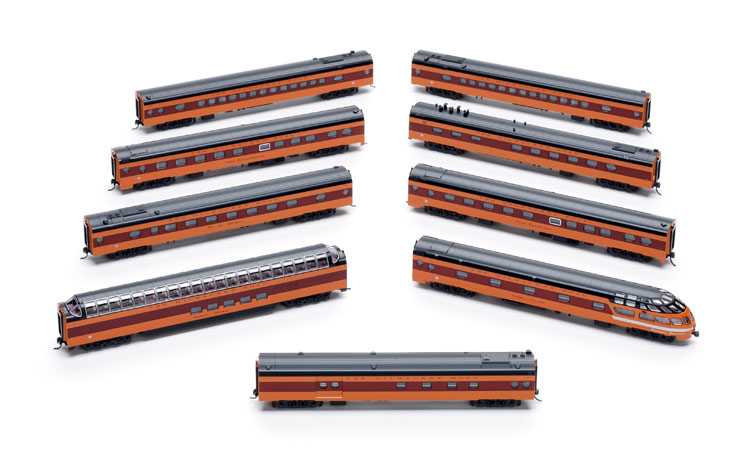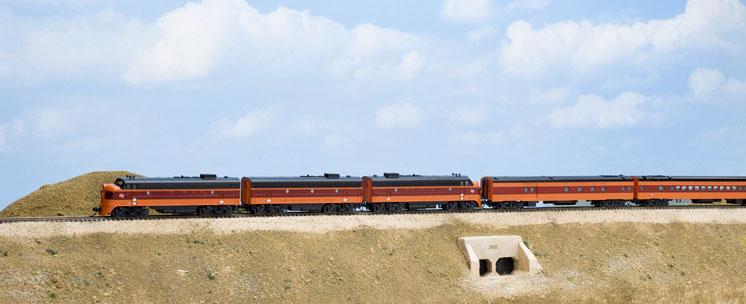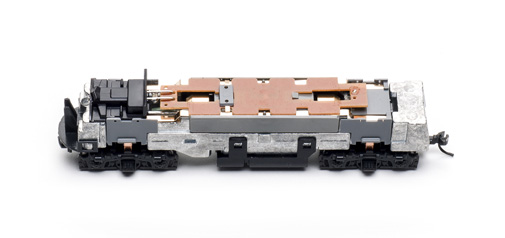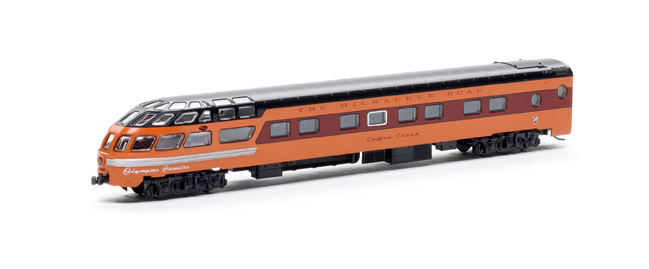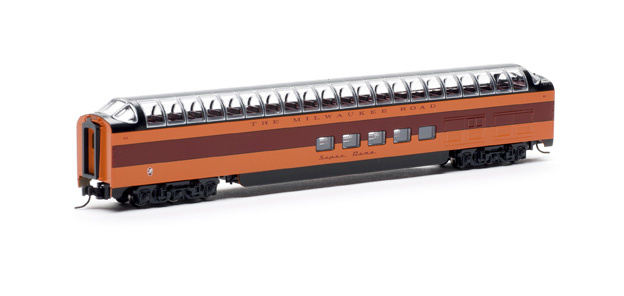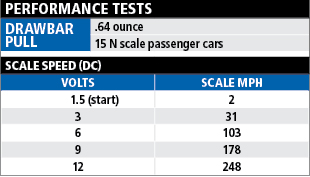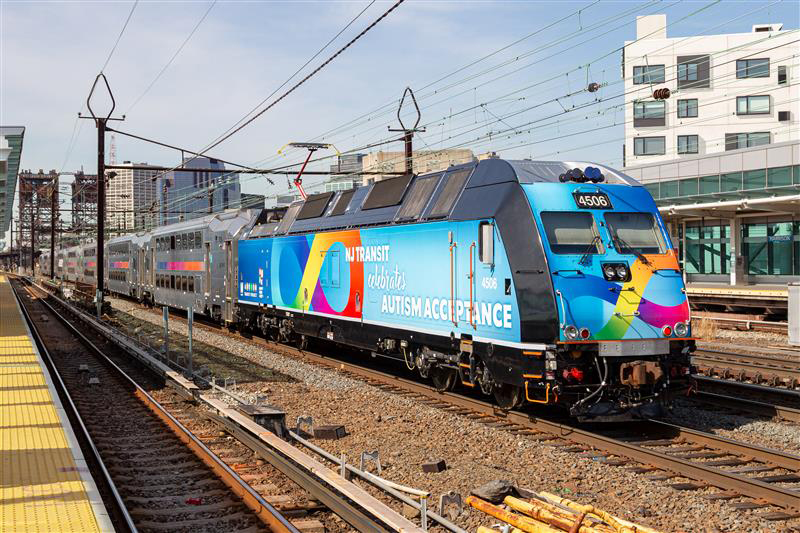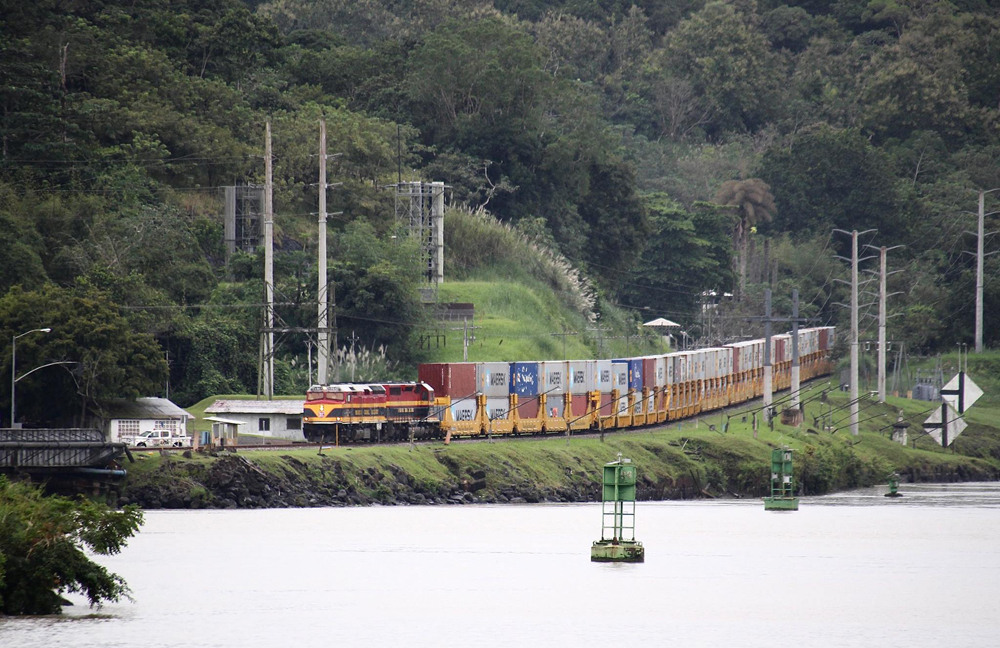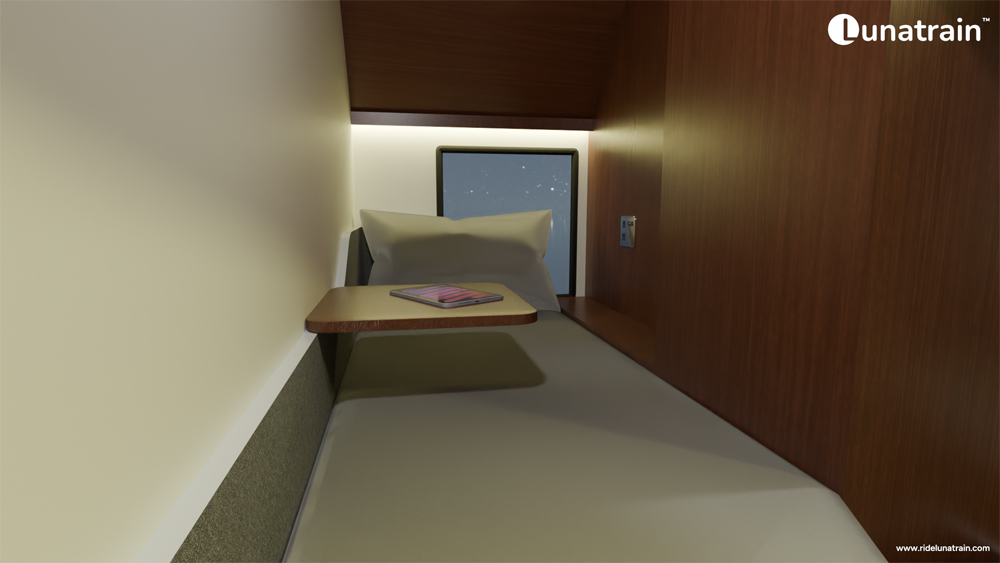Hiawatha is the name the Chicago, Milwaukee, St. Paul & Pacific, also known as the Milwaukee Road, used for its first streamlined passenger trains in 1935. By the late 1940s, there were Hiawathas providing fleet passage between many cities of the upper Midwest and the Pacific Northwest.
The Olympian Hiawatha was the Milwaukee Road’s high-speed connection between Chicago and Seattle- Tacoma, Wash. This orange-and-maroon streamliner offered full dome service and the CMStP&P’s signature Sky Top observation cars. Now for the first time as a plastic model, Kato USA has introduced an N scale version for passenger train modelers.
The prototype. The streamlined Olympian Hiawatha was inaugurated on June 29, 1947. Much of the train was home-built, but production backlogs at Pullman-Standard meant the first 18 months of service included older, heavyweight equipment. By January 1949, Pullman-Standard-built 10-roomette, 6-bedroom sleepers and eight double-bedroom Sky Top lounge cars had been added, creating a fully streamlined train.
For the 1952 Christmas holidays, the Milwaukee Road debuted the Super Domes, the first full-length dome cars. These were also from Pullman-Standard.
The home-built cars included a baggage-dormitory car, 48-seat coaches, a diner, and a Touralux sleeper. The Touralux cars offered an intermediate-priced ticket with 14 sections containing upper and lower berths.
The consist of the Olympian Hiawatha varied with demand. An RPO-express car that was part of the original consist was eventually dropped, and coaches were often added to accommodate Chicago-to-Minneapolis traffic on weekends and around holidays.
The trains were pulled by a variety of diesel-electric and electric locomotives. In 1950, EMD FP7s joined the power pool. Diesel locomotive types were mixed and matched as needed.
In 1957, the Milwaukee Road started painting its passenger equipment yellow and gray after entering into an agreement with the Union Pacific to handle UP’s City streamliners from Omaha to Chicago. The Armour Yellow was found to wear better than Milwaukee’s Harvest Orange and Royal Maroon.
By 1961, competition from highways and airlines had made it plain that rail passenger travel was not going to rebound, and the Milwaukee Road petitioned the Interstate Commerce Commission to drop the train. The Olympian Hiawatha made its last run on May 21, 1961.
The six Sky Top lounges and 10 Super Domes built for the train went to Canadian National in 1964. The home-built cars were either reassigned or converted to another use, such as diners 115 to 119 becoming storage cars in 1964.
The models. Kato USA’s nine-car set includes a baggage-dormitory, two 48-seat coaches, a Super Dome, a diner, a 14-section Touralux sleeper, two 10-6 sleepers, and a Sky Top lounge car.
Pulling the train is an FP7-F7B two-unit set. An additional FP7 is available to create a three-unit consist. All units are powered. The FP7s are new for this train. The FP7s and F7B are decorated in the Milwaukee Road’s as-delivered maroon, orange, and black scheme. The paint is opaque and color separations are sharp. Railroad-specific details include winterization hatches over the fourth radiator-fan housing on each unit.
All details are molded in place. Kato magnetic couplers are truck-mounted on the rear and frame-mounted on the front of the FP7s. Couplers are truck-mounted on the F7B.
The upper and lower headlights and the number boxes are illuminated on the FP7 when the locomotive is moving forward. In normal operation, only the lower light would be illuminated. The upper light is a signal light.
The mechanism is the same as in the Kato F3 we reviewed in the November 2014 MR, except it’s longer to match the longer frame of the FP7. All dimensions on the model match drawings published in General Motors 1500 H.P. “Lead” Unit FP7 Diesel-Electric Locomotive (General Motors, 1948).
The passenger cars in the set are all-new. I was able to compare the Pullman-Standard cars with drawings in The Official Pullman-Standard Library, Vol. 15: Western Railroads (RPC Publications Inc., 1994) by W. David Randall. Dimensions and room layouts all matched. The only deviation I found was the truck wheelbase. The book states the four-wheel trucks had an 8-foot wheelbase, but the model trucks measure 8′-6″, which is a more common size for passenger trucks.
Three of the four home-built cars are illustrated in the 1949-51 Car Builder’s Cyclopedia1 (Simmons-Boardman, 1949). Dimensions and layout for the baggage-dormitory, coaches, and diner match the drawings in the book.
The Milwaukee Road’s signature porthole and oval windows tie all of the cars together. All paint is opaque and sharply masked, and the lettering is clear and legible. One window on each of the 10-6 sleepers and on the Sky Top car has a silver frame, depicting the hinged sash that allowed the loading of stretcher-borne patients onto the train.
All of the cars are equipped for electrical pick-up. Kato offers a light board, no. 11-211/212, for modelers who wish to light their cars. The rear marker lights are illuminated on the Sky Top lounge.
On the test track. The DC-powered Kato FP7 started moving at 1.5V at 2 scale mph. It reached 103 scale mph at 6V, and hit 248 scale mph at 12V. The top speed of an FP7 with optional gearing was 89 mph.
Train Control Systems makes a drop-in Digital Command Control decoder for the FP7, no. K0D8-F. Decoder K0D8-D fits the F7B. According to a Kato rep, Digitrax plans to offer a drop-in decoder for the FP7, as well. A Digitrax DN163K0B fits the B unit. Kato also offers DCC-equipped locomotives.
The F-unit’s drawbar pull of .64 ounce is equivalent to 15 N scale passenger cars on straight and level track. I took the train to our Red Oak project model railroad, where the train had no trouble with the layout’s 13″ minimum radius curves and no. 6 turnouts.
The truck-mounted couplers on the cars kept them on the rails through crossovers and ladders and caused no problems when I reversed the train. One locomotive could easily pull all nine cars.
The Olympian Hiawatha is a distinctive train with its Sky Top lounge and Super Dome. Kato has done its usual high-quality job in bringing the model to N scale. This model would make a great addition to layouts set anywhere from Chicago to the Pacific Northwest.
Price: Nine-car set, $280; EMD FP7 and F7B locomotive two-pack, $190
(DC only), $270 (DCC); EMD FP7, $110 (DC), $150 (DCC)
Manufacturer
Kato USA Inc.
100 Remington Rd.
Schaumburg, IL 60173
www.katousa.com<
Roadname: Milwaukee Road
Era: 1953 to 1957 as decorated
Locomotive features
• Die-cast metal frame
• Can motor with dual brass flywheels
• Milwaukee Road winterization hatch
• Directional light-emitting diode (LED) headlight on A units
• Weights: 3.2 ounces (FP7), 3 ounces (F7B)
Passenger car features
• Flush-mounted window glazing
• Nystrom passenger car trucks
• All-wheel electrical pickup for interior lighting (light boards sold separately for $12 each)
• Illuminated LED marker lights on Sky Top lounge
• Weights: Baggage-dormitory, 1.1 ounce (.2 ounce less than National Model Railroad Association
• Recommended Practice 20.1 of 1.3 ounces for a 75-foot car); diner, coach, Touralux sleeper, and Sky Top lounge, 1.2 ounces (.2 ounce less than RP-20.1 of 1.4 ounces for an 85-foot car); 10-6 sleeper, 1.3 ounces (.1 ounce light); Super Dome, 1.4 ounces (matches RP-20.1 for an 85-foot car)
All
• Low-flange blackened metal wheels, in gauge
• Kato magnetic knuckle couplers, at correct height





